New Electric Power System Stability Evaluation Based on Game Theory Combination Weighting and Improved Cloud Model
Abstract
1. Introduction
- (1)
- Evaluation indices reflecting the characteristics of the new electric power system are mined, and a multi-level stability evaluation index system is constructed.
- (2)
- We perform combination weighting of three objective weighting methods based on game theory.
- (3)
- We improve the cloud model by combining weights.
2. Index System for Stability Evaluation
2.1. Analysis of Stability Factors
2.1.1. Safety
2.1.2. Adequacy
2.1.3. Flexibility
2.1.4. Adaptability
2.2. Construction of Evaluation Indicator System
2.3. Indicator Content and Calculation Methodology
2.3.1. Indices of Safety
- (1)
- Power quality
- (2)
- Distribution network safety
- (3)
- System operation
2.3.2. Indices of Adequacy
- (1)
- Generation capacity
- (2)
- System operational status
2.3.3. Indices of Flexibility
- (1)
- Grid side
- (2)
- Power supply side
- (3)
- Load side
- (4)
- Energy storage side
2.3.4. Indices of Adaptability
- (1)
- Grid structure
- (2)
- Economy.
- (3)
- Energy structure.
3. Evaluation Model for Stability
3.1. Index Weight Setting Based on Game Theory
3.1.1. Indicator Weight Calculation Method
3.1.2. Combination Weighting Theory Method Based on Game Theory
3.2. Stability Evaluation Model Based on an Improved Cloud Model
3.2.1. Basic Theory
3.2.2. The 3En Criterion of the Cloud Model
3.2.3. Determination of Standard Cloud Model
3.2.4. Comprehensive Cloud Evaluation
4. Results
4.1. Basic Data and Scenario Setting
4.2. Index Weight Calculation
4.3. Evaluation of the Improved Cloud Model
4.4. Comparison and Analysis
5. Discussion
- (1)
- The feasibility and applicability of the model proposed in this paper are verified by the results of the arithmetic examples. Meanwhile, the evaluation results provide a basis for identifying the vulnerability of new electric power system.
- (2)
- The evaluation results show that the stability of the electric power system in the region can be improved. Measures such as the improvement and modification of electronic power equipment and energy storage equipment can be used to minimize the adverse effects of a high proportion of new energy sources connected to the grid, which will improve the stability of the new electric power system.
- (3)
- The applicability and superiority of the improved cloud model are highlighted by comparing the conventional cloud model with the improved cloud model and finding that the improved cloud model improves the atomization characteristics.
6. Conclusions
Author Contributions
Funding
Institutional Review Board Statement
Informed Consent Statement
Data Availability Statement
Conflicts of Interest
References
- Fan, R.Q.; Yang, Y.; Xu, K.; Xu, W.T. An overview of typical characteristics and development challenges of new power systems under the “dual-carbon” goal. Sichuan Electr. Power Technol. 2023, 46, 10–14+58. [Google Scholar]
- Ren, D.W.; Xiao, J.Y.; Hou, J.M.; Du, E.S.; Jin, C.; Liu, Y. Construction and evolution of China’s new power system under dual carbon goal. Power Syst. Technol. 2022, 46, 3831–3839. [Google Scholar]
- Hong, J.J.; Wang, Z.H.; Li, J.L.; Xu, Y.F.; Xin, H. Effect of Interface Structure and Behavior on the Fluid Flow Characteristics and Phase Interaction in the Petroleum Industry: State of the Art Review and Outlook. Energy Fuels 2023, 37, 9914–9937. [Google Scholar] [CrossRef]
- Xu, Y.T.; Tan, Z.K.; Yuan, X.F.; Xie, B.M.; Chen, Y.F.; Wu, H. Power flow calculation for unbalanced distribution networks considering distributed generations. Electr. Meas. Instrum. 2019, 56, 27–32+80. [Google Scholar]
- Liu, K.C.; Zhong, M.; Zeng, P.L.; Zhu, L.G. Review on reliability assessment of smart distribution networks considering distributed renewable energy and energy storage. Electr. Meas. Instrum. 2021, 58, 1–11. [Google Scholar]
- Zheng, W.Y. Research on Static Voltage Stability Evaluation System of AC-DC Hybrid Power Grid. Bachelor’s Thesis, Shenyang Institute of Engineering, Shenyang, China, 2021. [Google Scholar]
- Li, W.H.; Zhao, D.M.; Wang, X.; Yu, H. Adaptability evaluation for the distribution equipment considering distributed generations. Power Syst. Clean Energy 2017, 33, 117–123. [Google Scholar]
- Huang, Q.H.; Wang, X.L.; Fan, J.J.; Wang, Y.F. Reliability and economy assessment of offshore wind farms. J. Eng. 2019, 16, 1554–1559. [Google Scholar] [CrossRef]
- Research on the New Power System Index System. Available online: http://kns.cnki.net/kcms/detail/10.1289.TM.20231012.1633.014.html (accessed on 16 October 2023).
- Yang, B.F. Construction and application of post evaluation system for provincial major power grid engineering investment projects. Money China 2022, 34, 72–74. [Google Scholar]
- Zhang, M.; Xia, R.P.; Xu, S.L.; Lu, D.L.; Hu, Y.S. Comprehensive evaluation of power quality based on variation coefficient synthetic weighting of subjective and objective weights. Mod. Electr. Power 2023, 40, 441–447. [Google Scholar]
- Zhu, Y.; Liu, X.; Mu, X.B.; Dai, F.J.; Xu, W.M.; Qian, W.J. Multi-index comprehensive evaluation of multi-station integrated energy system based on analytic hierarchy process and risk entropy weight. Electr. Meas. Instrum. 2022, 59, 128–136+143. [Google Scholar]
- Ai, X.; Zhao, X.Z.; Hu, H.Y.; Wang, Z.D.; Peng, D.; Zhao, L. G1-entropy-independence weight method in situational awareness of power grid development. Power Syst. Technol. 2020, 44, 3481–3490. [Google Scholar]
- Xiao, J.; Li, H.; Wang, B.; Song, C.H. Comprehensive matching evaluation method for integration of distributed generator into urban distribution network. Autom. Electr. Power Syst. 2020, 44, 44–51. [Google Scholar]
- Lin, L.; Wang, T.Z.; Lv, Y.B.; Qu, S.J.; Gao, Z.H. Comprehensive evaluation of dispatching operation management level of distribution Network based on combined weight and gray cloud clustering model. J. North China Electr. Power Univ. (Nat. Sci. Ed.) 2022, 49, 31–40+80. [Google Scholar]
- Pathan, M.I.; Alowaifeer, M.; Almuhaini, M.; Djokic, S.Z. Reliability evaluation of smart distribution grids with renewable energy sources and demand side management. Arab. J. Sci. Eng. 2020, 45, 6347–6360. [Google Scholar] [CrossRef]
- Adaptability Evaluation of Distributed Photovoltaic Access Distribution Network. Available online: http://kns.cnki.net/kcms/detail/23.1202.TH.20220602.1656.006.html (accessed on 6 June 2022).
- Liu, R.K.; Yao, J.; Pei, J.X.; Wang, X.W.; Sun, P.; Guo, X.L. Dynamic stability analysis of the weak grid connected DFIG based wind turbines under severe symmetrical faults. In Proceedings of the 2018 International Conference on Power System Technology (POWERCON), Guangzhou, China, 1 November 2018. [Google Scholar]
- Power System Transient Stability Assessment Based on Probability Prediction and Intelligent Enhancement of MLE. Available online: http://kns.cnki.net/kcms/detail/11.2107.TM.20231007.1321.002.html (accessed on 8 October 2023).
- Meridji, T.; Joos, G.; Restrepo, J. A power system stability assessment framework using machine learning. Electr. Power Syst. Res. 2023, 216, 108981. [Google Scholar] [CrossRef]
- Cai, W.B.; Cheng, X.L.; Nan, J.N.; Lv, H.X.; Li, Y.; Li, J.Y. Assessment and analysis of adequacy of flexibility resource of power system with high proportion new energy. Electr. Drive 2022, 52, 57–62. [Google Scholar]
- Zhang, L.Z.; Xu, T.; Song, S.Q.; Zhang, F. Evaluation method and guarantee mechanism of power generation capacity adequacy in electricity market. Autom. Electr. Power Syst. 2020, 44, 55–63. [Google Scholar]
- Holttinen, H.; Tuohy, A.; Milligan, M.; Lannoye, E. The flexibility workout: Managing variable resources and assessing the need for power system modification. IEEE Power Energy Mag. 2013, 11, 53–62. [Google Scholar] [CrossRef]
- Yang, L.J.; Li, H.Q.; Yu, X.Y.; Zhao, J.S.; Liu, W.Y. Multi-objective day-ahead optimal scheduling of isolated microgrid considering flexibility. Power Syst. Technol. 2018, 42, 1432–1440. [Google Scholar]
- Chen, W.; Liu, Y.; Liu, X.Y. Transmission expansion planning considering adaptability of grid to short-circuit current. Sichuan Electr. Power Technol. 2018, 41, 74–77. [Google Scholar]
- Du, M.K.; Huang, Y.; Liu, J.Y.; Lu, L.; Jiang, L.; Zhang, Q.M. Comprehensive evaluation on grid adaptability considering the access of cascaded power stations under planning and development. Proc. CSU-EPSA 2021, 33, 1–8+16. [Google Scholar]
- Jia, W.J.; Luo, P. Power Supply and Distribution System; Chongqing University Press: Chongqing, China, 2016; pp. 260–265. [Google Scholar]
- Yang, J.H.; Wu, J.H.; Saniye, M.; Zhang, H.; Yang, J. Research on security evaluation of power system with new energy. Mod. Electr. Power 2023, 40, 651–659. [Google Scholar]
- Xu, J. Research on the capacity credibility of wind farms based on the reliability index LOLP. Energy Eng. 2011, 5, 38–40+49. [Google Scholar]
- Research on Construction of Index System and Comprehensive Evaluation Method of Development Level of New Power System. Available online: https://www.chndoi.org/Resolution/Handler?doi=10.13335/j.1000-3673.pst.2023.2291 (accessed on 14 March 2024).
- Xiao, Y.Y. Practical Research and Application of Large Power Grid Adequacy Assessment. Bachelor’s Thesis, Huazhong University of Science and Technology, Wuhan, China, 2018. [Google Scholar]
- Li, J.H.; Long, Y.F.; Wen, J.Y.; Luo, W.H. Assessment of wind power capacity in power systems to meet the adequacy indexes. Power Syst. Technol. 2014, 38, 3396–3404. [Google Scholar]
- Wang, H.K.; Wang, S.S.; Pan, Z.X.; Wang, J.M. Optimal scheduling method for flexibility enhancement of distribution networks containing high penetration distributed power source. Autom. Electr. Power Syst. 2018, 42, 86–93. [Google Scholar]
- Wu, J.; Lu, Z.X.; Qiao, Y.; Yang, H.J. Optimisation of wind storage plant operation considering dynamic charging and discharging efficiency characteristics of energy storage plants. Autom. Electr. Power Syst. 2018, 42, 41–47+101. [Google Scholar]
- National Energy Administration. Power Transformer Operation Regulations; China Electric Power Press: Beijing, China, 2010; pp. 15–19.
- Li, S.X.; Zhou, B.X.; Tang, H.; Peng, Z.G. The improved algorithm model of capacity-load ratio in distribution network of remote areas. Electr. Meas. Instrum. 2016, 53, 27–31. [Google Scholar]
- Li, T.H.; Xue, J.; Xia, W.; Ding, Y. Application of combination weighting method and comprehensive index method based on crack theory in ecological waterway assessment of Yangtze River ecological. J. Appl. Basic Eng. Sci. 2019, 27, 36–49. [Google Scholar]
- Jiang, H.; Wu, J.H.; Saniye, M.; Zhang, Q.; Yao, L.; Kao, Y. Comprehensive vulnerability evaluation of power systems structure based on VIKOR method and complex network theory. Water Resour. Power 2023, 41, 216–220. [Google Scholar]
- Liu, X.P.; Liu, M.H.; Huang, R.; Chen, X.Q.; Xu, H.T.; Xu, R.H. Research on performance evaluation method of smart energy meter based on grey correlation degree. Electr. Meas. Instrum. 2020, 57, 136–141. [Google Scholar]
- He, T.; Ma, J. Reliability evaluation of CBTC based on cloud modeling and combination weighting method. J. Chongqing Univ. 2023, 46, 130–139. [Google Scholar]
- Lin, G.Q.; Mo, T.W.; Ye, X.J.; Han, C.; Lin, Z.Z.; Wang, Z.K. Critical node identification of power networks based on TOPSIS and CRITIC methods. High Volt. Eng. 2018, 44, 3383–3389. [Google Scholar]
- Li, D.Y.; Liu, C.Y. Study on the Universality of the Normal Cloud Model. Strateg. Study CAE 2004, 6, 28–34. [Google Scholar]
- Yan, J.; Li, N.; Liu, Y.Q.; Li, L.; Kong, D.; Long, Q. Short-term uncertainty forecasting method for wind power based on real-time switching cloud model. Autom. Electr. Power Syst. 2019, 43, 17–23. [Google Scholar]
- Yang, M.; Zhang, L.B.; Cui, Y.; Yang, Q.Q.; Huang, B.Y. Wind speed-power curve modeling method based on hybrid half-cloud model. Electr. Power Autom. Equip. 2020, 40, 106–112. [Google Scholar]
- Cheng, J.T.; Duan, Z.M. Cloud model based sine cosine algorithm for solving optimization problems. Evol. Intell. 2019, 12, 503–514. [Google Scholar] [CrossRef]
- On the Issuance of “Zhejiang Province Renewable Energy Development Fourteen Five-Year Plan” Notice. Available online: https://fzggw.zj.gov.cn/art/2021/6/23/art_1229123366_2305635.html (accessed on 23 June 2021).
- On the Issuance of “Zhejiang Province, Renewable Energy Development “14th Five-Year Plan” Notice. Available online: https://fzggw.zj.gov.cn/art/2021/6/24/art_1229539890_4670809.html (accessed on 25 May 2021).
- State Grid Corporation of China. The Guide of Planning and Design of Distribution Network; China Electric Power Press: Beijing, China, 2021; pp. 1–30. [Google Scholar]
- China Southern Power Grid Company. Table of New Power System Technical Standard System and Roadmap for Standard Preparation Actions; China Electric Power Press: Beijing, China, 2022; pp. 10–50. [Google Scholar]
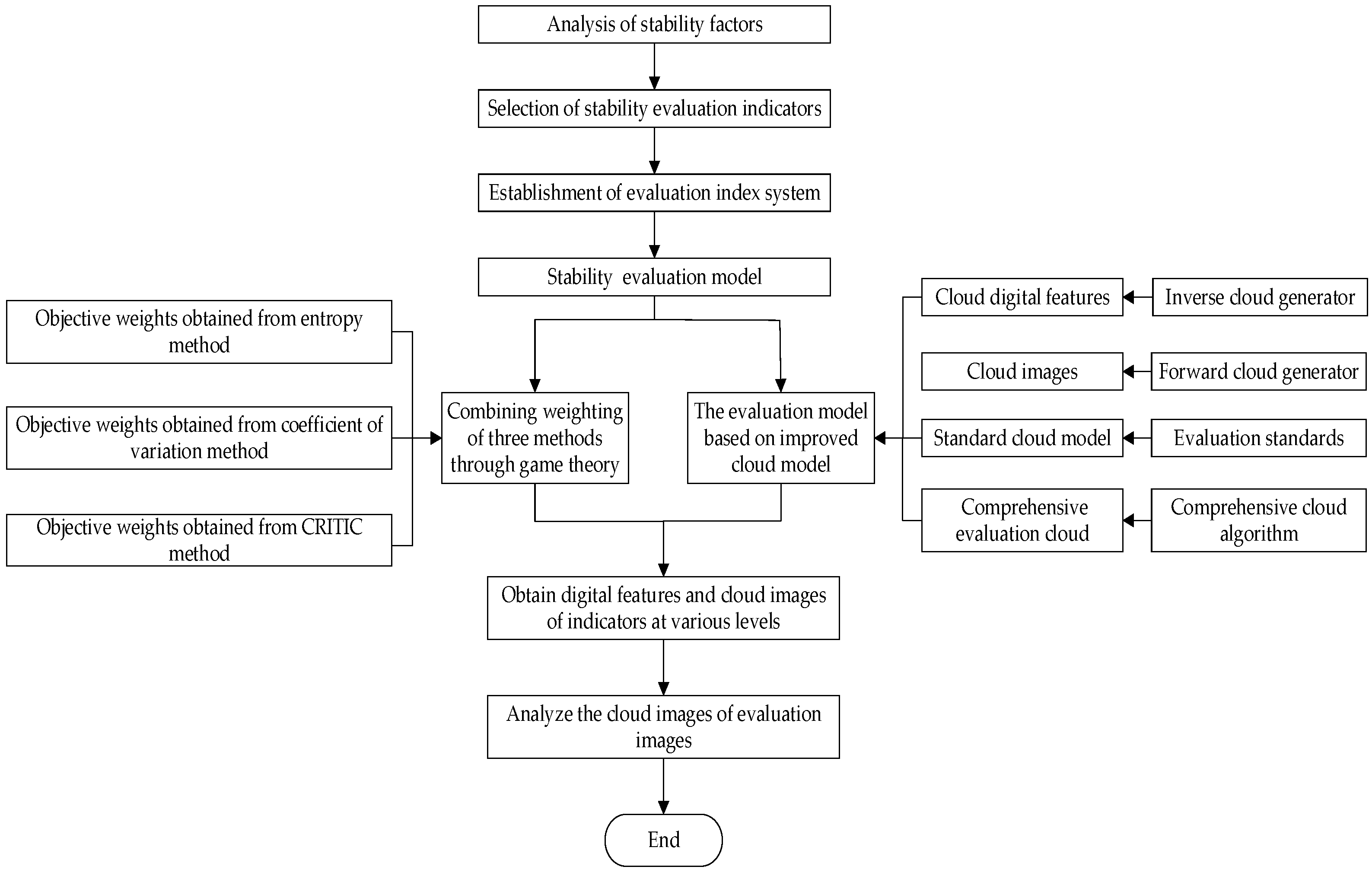

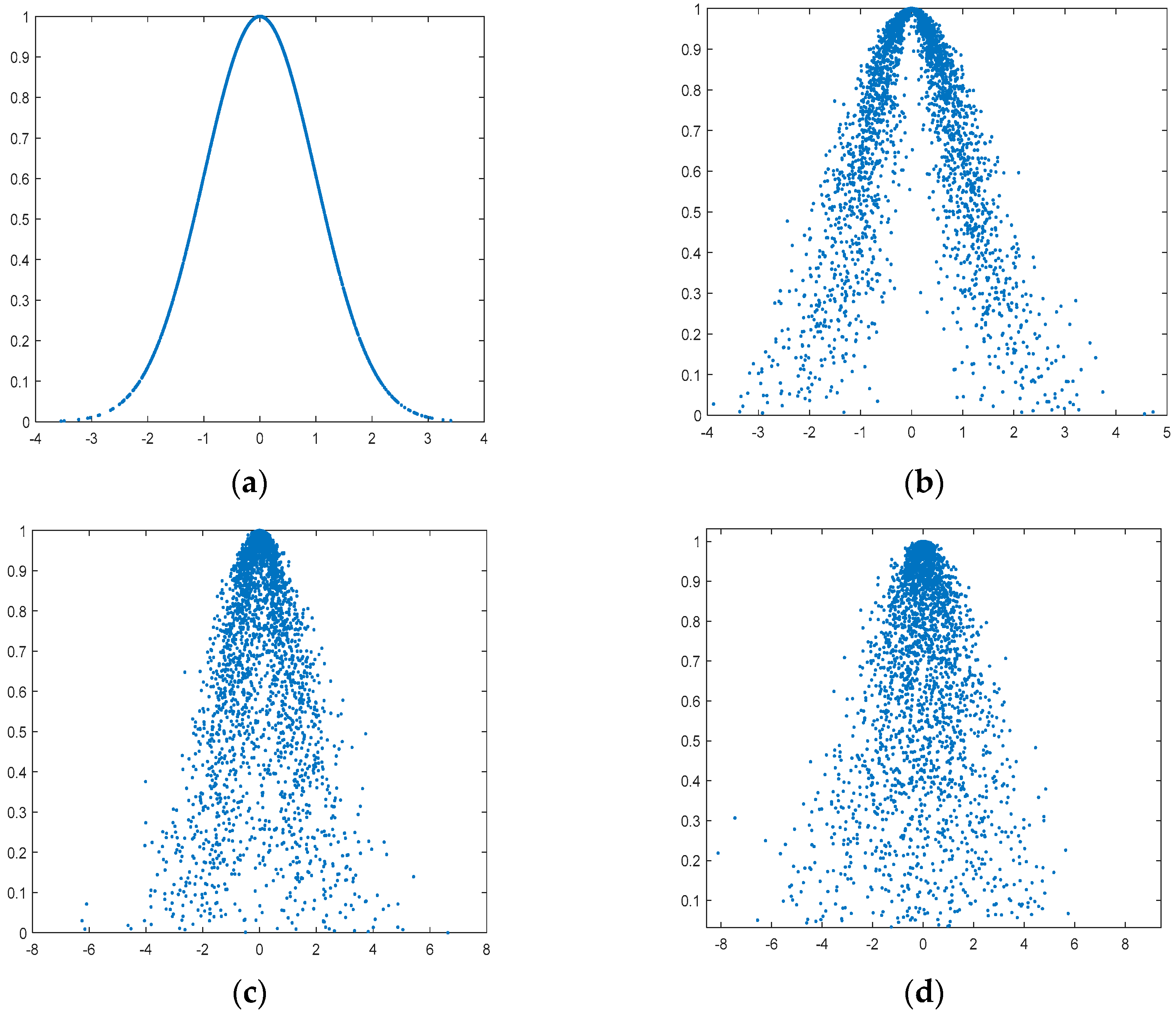
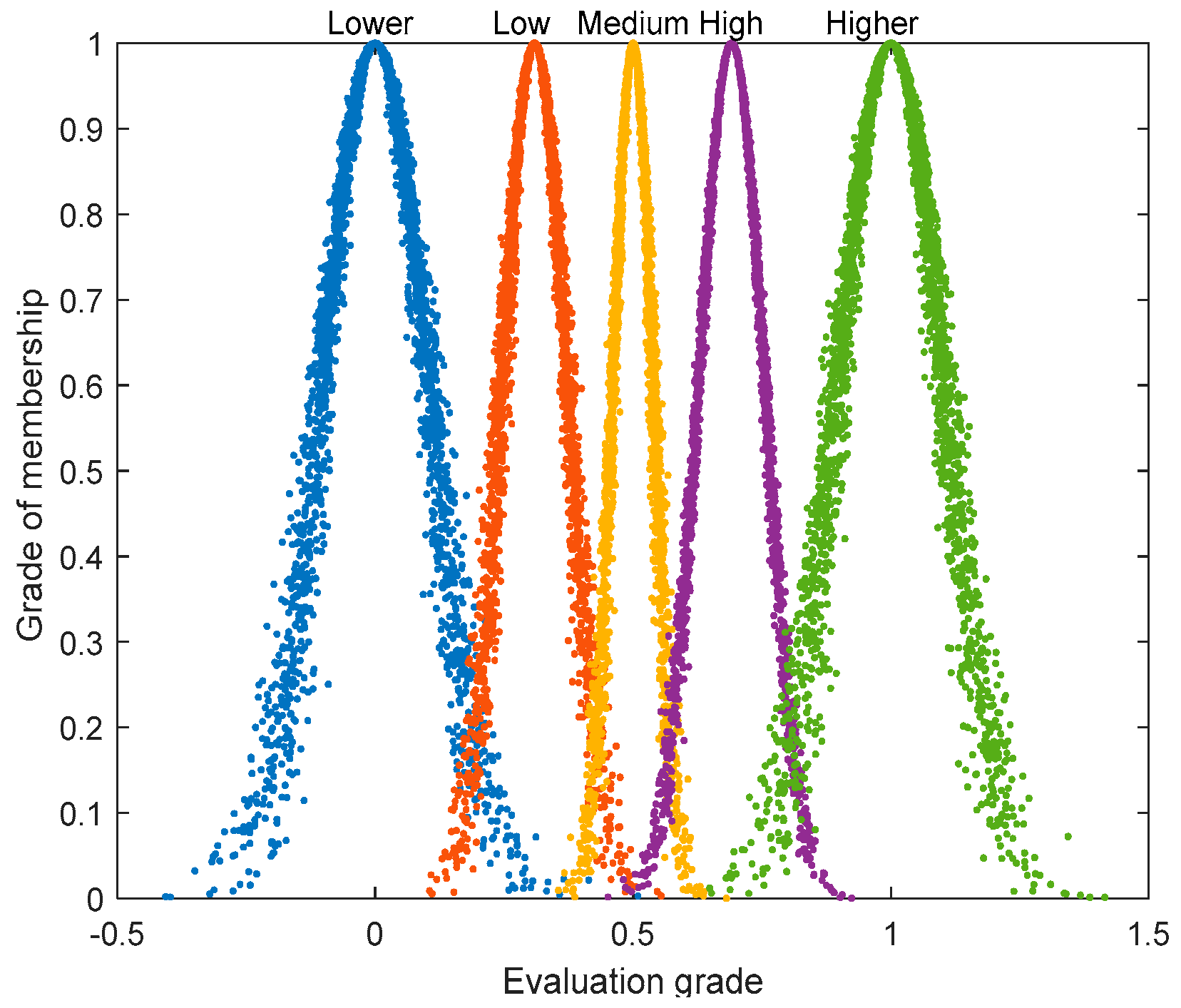
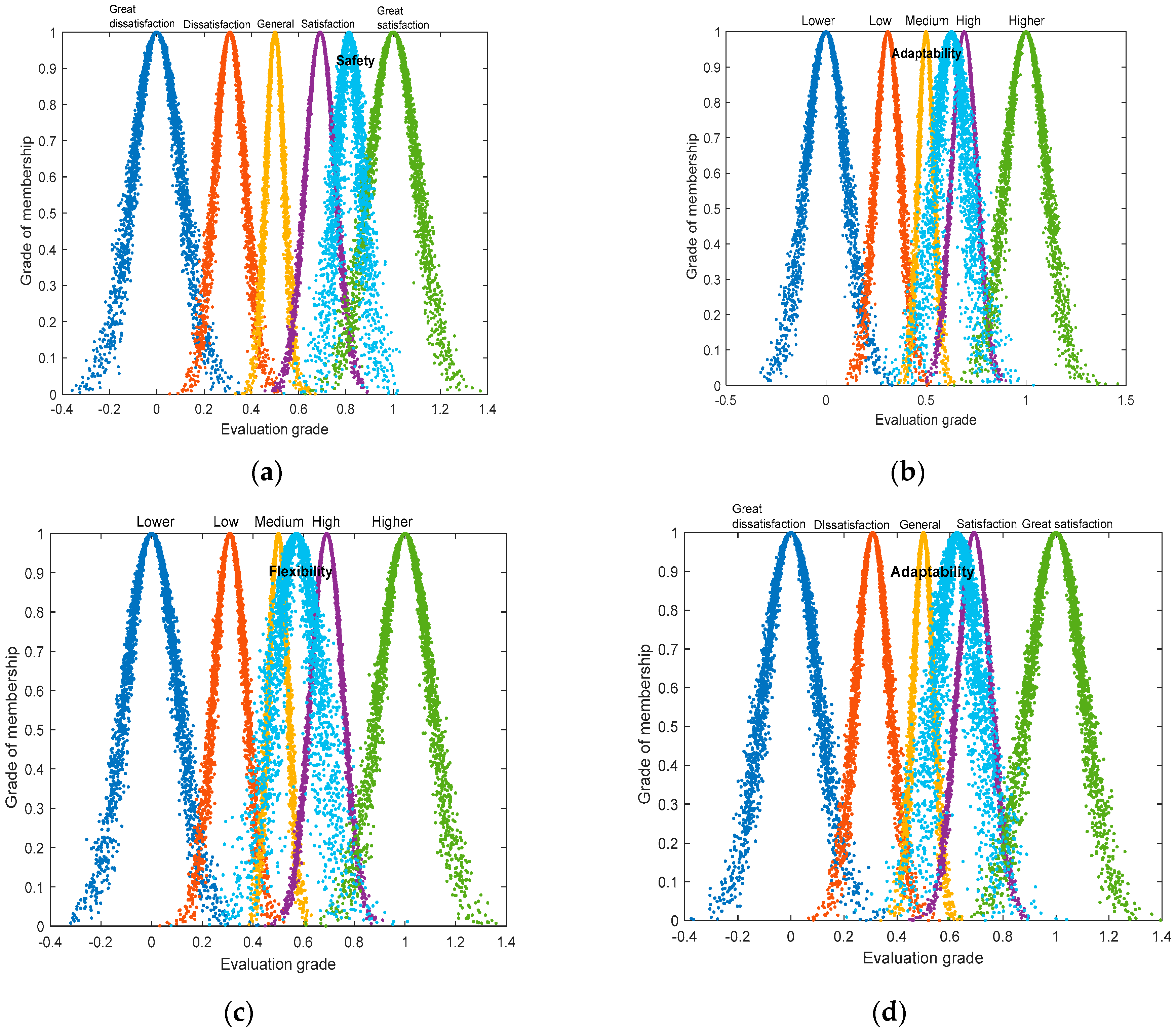
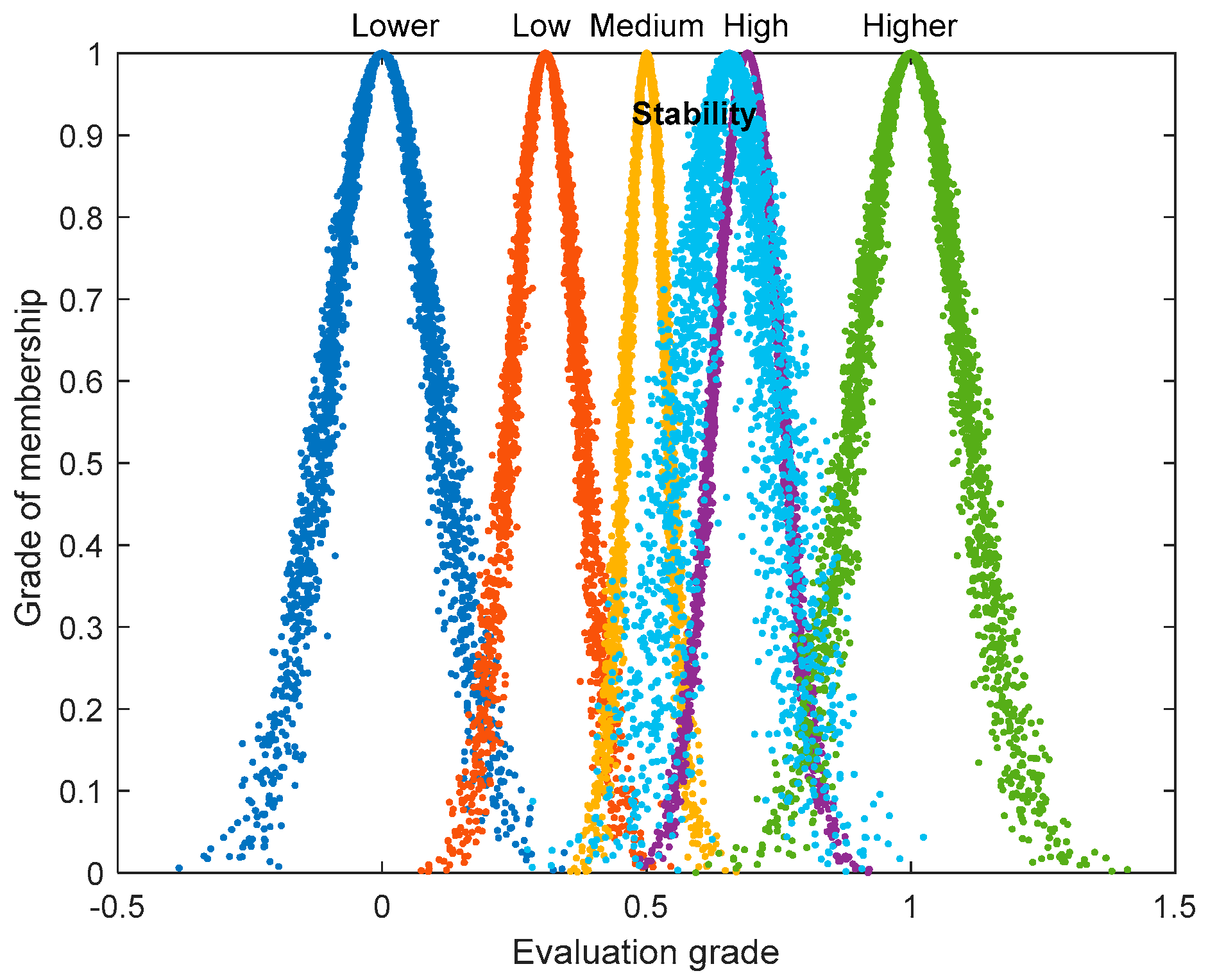
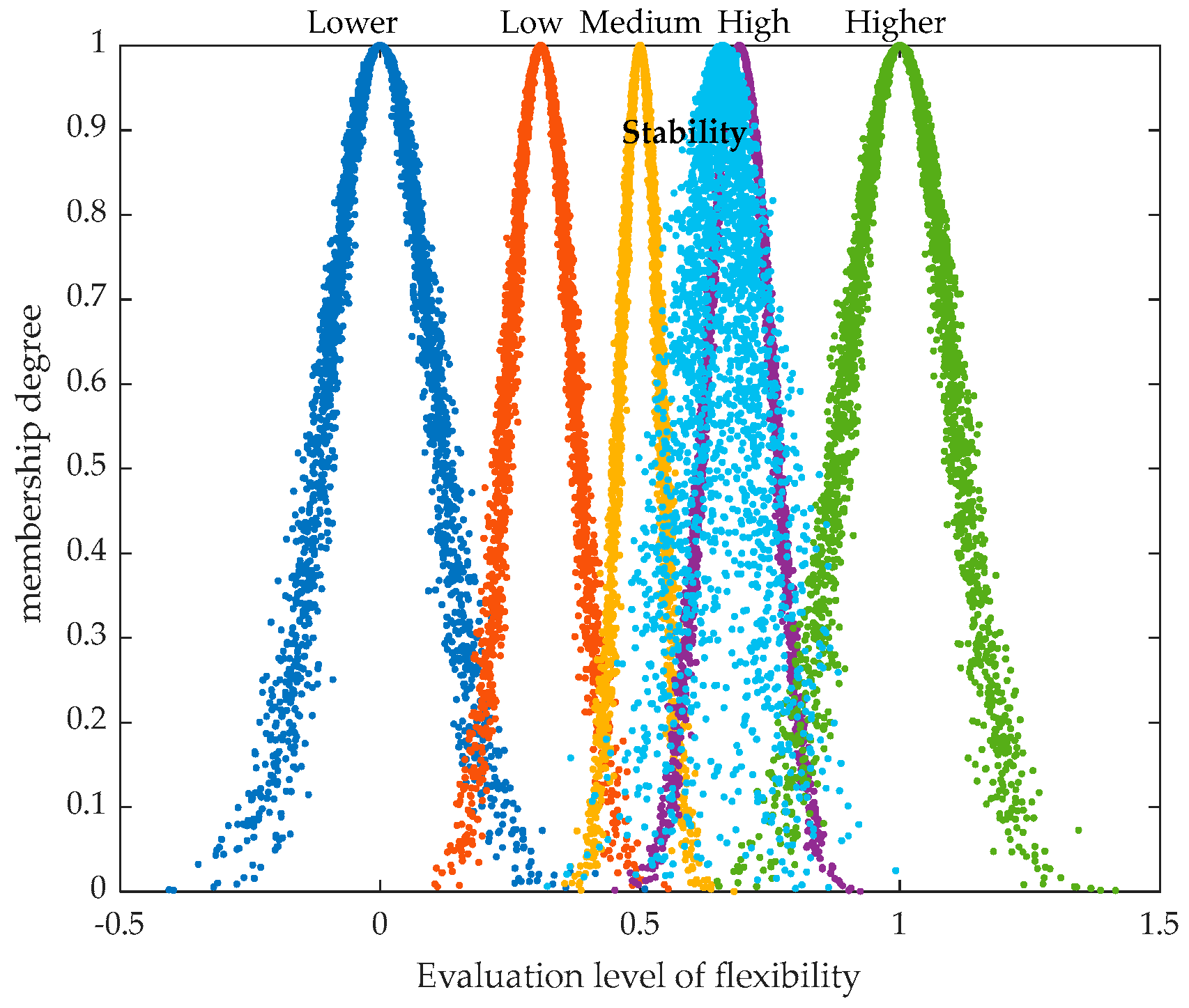
| First-Level Indicators | Second-Level Indicators | Third-Level Indicators |
|---|---|---|
| Safety A | Power quality | Voltage qualification rate |
| Voltage deviation rate | ||
| Average reliability of power supply | ||
| Distribution network safety | Harmonic current exceedance rate | |
| Frequency deviation rate | ||
| Transformer reliability | ||
| System operation | Peak–valley ratio | |
| Average electricity load rate | ||
| Adequacy B | Generation capacity | Loss of load probability |
| Loss of load expectations | ||
| Expected energy not supplied | ||
| System operational status | Probability of lacking peaking regulation | |
| System complementarity | ||
| Energy supply shortage rate | ||
| Flexibility C | Grid side | Line capacity adequacy |
| Transformer upward capacity adequacy | ||
| Transformer downward capacity adequacy | ||
| Power supply side | New energy volatility | |
| New energy consumption rate | ||
| New energy penetration rate | ||
| Load side | Net load fluctuation rate | |
| New load access rate | ||
| Energy storage side | Energy storage allocation ratio | |
| Charge and discharge efficiency of energy storage | ||
| Adaptability D | Grid structure | Current qualification rate |
| Qualification rate of three-phase unbalance | ||
| Interstation contact ratio | ||
| Transformer load rate | ||
| Line load rate | ||
| Economy | Line overload rate | |
| Transformer overload rate | ||
| Capacity–load ratio | ||
| Grid line loss contribution ratio | ||
| Elasticity coefficient of power production | ||
| Energy structure | Percentage of new energy generation | |
| New energy load factor | ||
| Wind abandonment rate | ||
| Rate of abandoned light | ||
| New energy emission reduction |
| Evaluation Standard | Cloud Model Feature Parameters |
|---|---|
| Lower | (0.000, 0.103, 0.008) |
| Low | (0.309, 0.064, 0.005) |
| Medium | (0.500, 0.039, 0.003) |
| High | (0.691, 0.064, 0.005) |
| Higher | (1.000, 0.103, 0.008) |
| First-Level Indicators | Weight | Second-Level Indicators | Weight | Third-Level Indicators | Entropy Method | Coefficient of Variation Method | CRITIC Method | Combined Weight |
|---|---|---|---|---|---|---|---|---|
| A | 0.237 | 0.100 | 0.024 | 0.024 | 0.022 | 0.023 | ||
| 0.060 | 0.046 | 0.025 | 0.049 | |||||
| 0.028 | 0.029 | 0.025 | 0.028 | |||||
| 0.088 | 0.025 | 0.025 | 0.044 | 0.027 | ||||
| 0.029 | 0.029 | 0.044 | 0.031 | |||||
| 0.032 | 0.032 | 0.021 | 0.030 | |||||
| 0.049 | 0.024 | 0.024 | 0.040 | 0.026 | ||||
| 0.023 | 0.023 | 0.021 | 0.023 | |||||
| B | 0.163 | 0.080 | 0.024 | 0.025 | 0.019 | 0.024 | ||
| 0.028 | 0.028 | 0.019 | 0.027 | |||||
| 0.030 | 0.030 | 0.020 | 0.029 | |||||
| 0.083 | 0.033 | 0.033 | 0.021 | 0.031 | ||||
| 0.030 | 0.030 | 0.020 | 0.029 | |||||
| 0.024 | 0.024 | 0.020 | 0.023 | |||||
| C | 0.273 | 0.082 | 0.027 | 0.027 | 0.019 | 0.026 | ||
| 0.025 | 0.026 | 0.044 | 0.028 | |||||
| 0.026 | 0.027 | 0.044 | 0.028 | |||||
| 0.080 | 0.026 | 0.027 | 0.019 | 0.026 | ||||
| 0.026 | 0.026 | 0.044 | 0.028 | |||||
| 0.027 | 0.027 | 0.019 | 0.026 | |||||
| 0.054 | 0.026 | 0.027 | 0.019 | 0.026 | ||||
| 0.025 | 0.026 | 0.044 | 0.028 | |||||
| 0.057 | 0.028 | 0.029 | 0.044 | 0.030 | ||||
| 0.025 | 0.025 | 0.044 | 0.027 | |||||
| D | 0.327 | 0.114 | 0.021 | 0.023 | 0.016 | 0.021 | ||
| 0.021 | 0.023 | 0.017 | 0.021 | |||||
| 0.022 | 0.025 | 0.016 | 0.024 | |||||
| 0.026 | 0.027 | 0.017 | 0.026 | |||||
| 0.023 | 0.022 | 0.016 | 0.022 | |||||
| 0.101 | 0.019 | 0.019 | 0.019 | 0.019 | ||||
| 0.020 | 0.020 | 0.018 | 0.019 | |||||
| 0.023 | 0.021 | 0.019 | 0.022 | |||||
| 0.020 | 0.024 | 0.016 | 0.021 | |||||
| 0.021 | 0.020 | 0.018 | 0.020 | |||||
| 0.110 | 0.022 | 0.020 | 0.031 | 0.022 | ||||
| 0.022 | 0.021 | 0.032 | 0.023 | |||||
| 0.021 | 0.020 | 0.022 | 0.021 | |||||
| 0.020 | 0.021 | 0.021 | 0.021 | |||||
| 0.026 | 0.025 | 0.022 | 0.023 |
| First-Level Indicators | Digital Features of Cloud Model (Ex,En,He) | Second-Level Indicators | Digital Features of Cloud Model (Ex,En,He) | Third-Level Indicators | Ex | En | He |
|---|---|---|---|---|---|---|---|
| A | (0.813, 0.055, 0.018) | (0.799, 0.052, 0.017) | 0.947 | 0.057 | 0.018 | ||
| 0.747 | 0.031 | 0.010 | |||||
| 0.767 | 0.114 | 0.037 | |||||
| (0.844, 0.072, 0.023) | 0.797 | 0.173 | 0.054 | ||||
| 0.943 | 0.006 | 0.002 | |||||
| 0.787 | 0.058 | 0.019 | |||||
| (0.787, 0.031, 0.011) | 0.827 | 0.020 | 0.007 | ||||
| 0.743 | 0.044 | 0.015 | |||||
| B | (0.702, 0.110, 0.031) | (0.679, 0.078, 0.021) | 0.700 | 0.050 | 0.016 | ||
| 0.667 | 0.086 | 0.024 | |||||
| 0.673 | 0.089 | 0.022 | |||||
| (0.723, 0.157, 0.047) | 0.707 | 0.086 | 0.028 | ||||
| 0.720 | 0.109 | 0.034 | |||||
| 0.750 | 0.359 | 0.099 | |||||
| C | (0.571, 0.091, 0.027) | (0.562, 0.122, 0.039) | 0.637 | 0.170 | 0.056 | ||
| 0.457 | 0.056 | 0.018 | |||||
| 0.597 | 0.145 | 0.044 | |||||
| (0.507, 0.072, 0.023) | 0.533 | 0.131 | 0.043 | ||||
| 0.477 | 0.047 | 0.014 | |||||
| 0.513 | 0.045 | 0.015 | |||||
| (0.591, 0.103, 0.032) | 0.617 | 0.178 | 0.055 | ||||
| 0.567 | 0.037 | 0.012 | |||||
| (0.653, 0.063, 0.013) | 0.590 | 0.084 | 0.014 | ||||
| 0.723 | 0.038 | 0.013 | |||||
| D | (0.627, 0.084, 0.026) | (0.647, 0.084, 0.025) | 0.890 | 0.077 | 0.024 | ||
| 0.603 | 0.047 | 0.014 | |||||
| 0.593 | 0.081 | 0.026 | |||||
| 0.640 | 0.075 | 0.021 | |||||
| 0.510 | 0.142 | 0.042 | |||||
| (0.643, 0.115, 0.036) | 0.627 | 0.114 | 0.033 | ||||
| 0.617 | 0.133 | 0.040 | |||||
| 0.747 | 0.153 | 0.051 | |||||
| 0.537 | 0.071 | 0.024 | |||||
| 0.683 | 0.103 | 0.032 | |||||
| (0.570, 0.040, 0.013) | 0.660 | 0.050 | 0.016 | ||||
| 0.523 | 0.035 | 0.012 | |||||
| 0.577 | 0.043 | 0.013 | |||||
| 0.575 | 0.042 | 0.012 | |||||
| 0.530 | 0.037 | 0.011 |
Disclaimer/Publisher’s Note: The statements, opinions and data contained in all publications are solely those of the individual author(s) and contributor(s) and not of MDPI and/or the editor(s). MDPI and/or the editor(s) disclaim responsibility for any injury to people or property resulting from any ideas, methods, instructions or products referred to in the content. |
© 2024 by the authors. Licensee MDPI, Basel, Switzerland. This article is an open access article distributed under the terms and conditions of the Creative Commons Attribution (CC BY) license (https://creativecommons.org/licenses/by/4.0/).
Share and Cite
Tang, M.; Li, R.; Dai, X.; Yu, X.; Cheng, X.; Yang, S. New Electric Power System Stability Evaluation Based on Game Theory Combination Weighting and Improved Cloud Model. Sustainability 2024, 16, 6189. https://doi.org/10.3390/su16146189
Tang M, Li R, Dai X, Yu X, Cheng X, Yang S. New Electric Power System Stability Evaluation Based on Game Theory Combination Weighting and Improved Cloud Model. Sustainability. 2024; 16(14):6189. https://doi.org/10.3390/su16146189
Chicago/Turabian StyleTang, Mingrun, Ruoyang Li, Xinyin Dai, Xuefeng Yu, Xiaoyu Cheng, and Shuxia Yang. 2024. "New Electric Power System Stability Evaluation Based on Game Theory Combination Weighting and Improved Cloud Model" Sustainability 16, no. 14: 6189. https://doi.org/10.3390/su16146189
APA StyleTang, M., Li, R., Dai, X., Yu, X., Cheng, X., & Yang, S. (2024). New Electric Power System Stability Evaluation Based on Game Theory Combination Weighting and Improved Cloud Model. Sustainability, 16(14), 6189. https://doi.org/10.3390/su16146189






